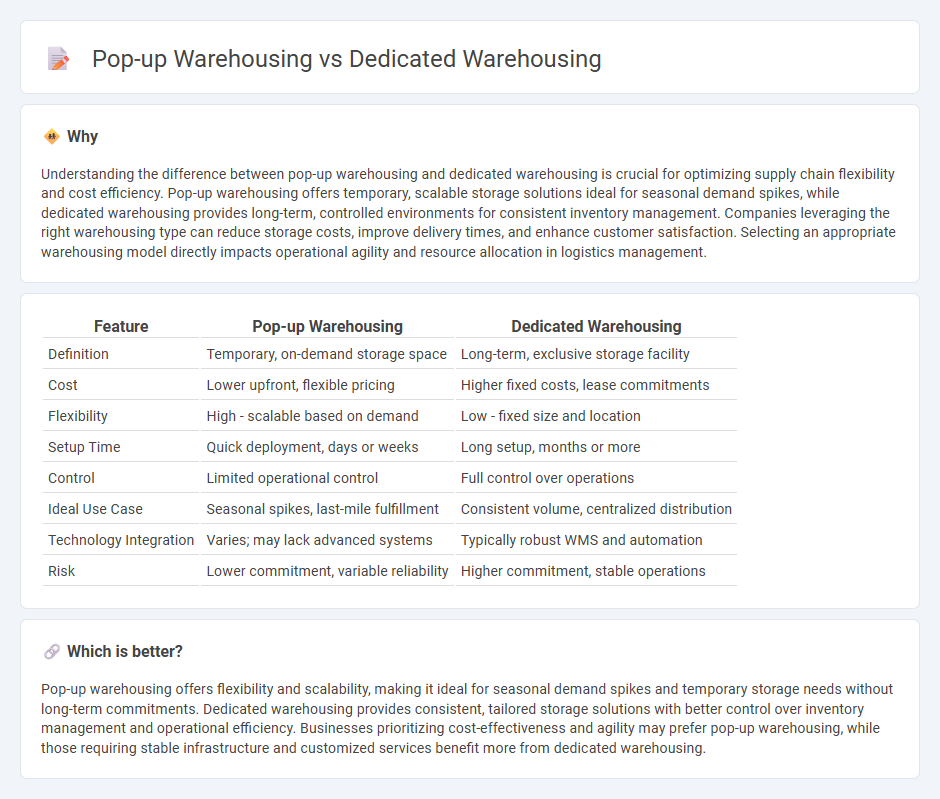
Pop-up warehousing offers flexible, short-term storage solutions ideal for seasonal demand spikes, while dedicated warehousing provides long-term, customized space tailored to specific business needs. Pop-up facilities enable rapid scalability and cost-efficiency without long-term commitments, whereas dedicated warehouses ensure consistent inventory management and operational control. Explore the advantages of each warehousing model to optimize your supply chain strategy.
Why it is important
Understanding the difference between pop-up warehousing and dedicated warehousing is crucial for optimizing supply chain flexibility and cost efficiency. Pop-up warehousing offers temporary, scalable storage solutions ideal for seasonal demand spikes, while dedicated warehousing provides long-term, controlled environments for consistent inventory management. Companies leveraging the right warehousing type can reduce storage costs, improve delivery times, and enhance customer satisfaction. Selecting an appropriate warehousing model directly impacts operational agility and resource allocation in logistics management.
Comparison Table
| Feature | Pop-up Warehousing | Dedicated Warehousing |
|---|---|---|
| Definition | Temporary, on-demand storage space | Long-term, exclusive storage facility |
| Cost | Lower upfront, flexible pricing | Higher fixed costs, lease commitments |
| Flexibility | High - scalable based on demand | Low - fixed size and location |
| Setup Time | Quick deployment, days or weeks | Long setup, months or more |
| Control | Limited operational control | Full control over operations |
| Ideal Use Case | Seasonal spikes, last-mile fulfillment | Consistent volume, centralized distribution |
| Technology Integration | Varies; may lack advanced systems | Typically robust WMS and automation |
| Risk | Lower commitment, variable reliability | Higher commitment, stable operations |
Which is better?
Pop-up warehousing offers flexibility and scalability, making it ideal for seasonal demand spikes and temporary storage needs without long-term commitments. Dedicated warehousing provides consistent, tailored storage solutions with better control over inventory management and operational efficiency. Businesses prioritizing cost-effectiveness and agility may prefer pop-up warehousing, while those requiring stable infrastructure and customized services benefit more from dedicated warehousing.
Connection
Pop-up warehousing complements dedicated warehousing by providing flexible, temporary storage solutions that accommodate seasonal demand spikes or supply chain disruptions without long-term commitment. Dedicated warehousing offers consistent, long-term storage with specialized infrastructure, while pop-up warehousing enables scalable space expansion in proximity to key distribution hubs. Integrating both models enhances overall logistics efficiency by balancing cost control with agility in inventory management.
Key Terms
Long-term contracts
Dedicated warehousing involves long-term contracts that provide businesses with exclusive storage space and consistent operational control, ensuring stability in inventory management. Pop-up warehousing, in contrast, offers flexible, short-term solutions without long-term commitments, catering to seasonal or fluctuating storage demands. Explore detailed comparisons to determine which warehousing model best aligns with your operational needs and contract preferences.
Flexibility
Dedicated warehousing offers fixed storage space tailored to long-term inventory management, ensuring consistent capacity and control for businesses with steady demand. Pop-up warehousing provides flexible, short-term storage solutions ideal for seasonal spikes or fluctuating inventory needs, allowing companies to scale operations quickly without long-term commitments. Explore how these warehousing models can optimize your supply chain flexibility and reduce overhead costs.
Infrastructure
Dedicated warehousing offers fixed, purpose-built facilities with advanced infrastructure such as climate control, security systems, and automated inventory management, ensuring consistent operational efficiency. Pop-up warehousing utilizes temporary spaces, often lacking specialized infrastructure but providing flexibility for fluctuating storage needs and eases rapid market entry. Explore how infrastructure impacts warehousing strategy and cost-effectiveness to optimize your supply chain solutions.
Source and External Links
What is Dedicated Warehousing and How does it Work? - Dedicated warehousing is a logistics strategy where a business outsources its entire storage and distribution to a 3PL provider, with all warehousing resources dedicated exclusively to that single company, allowing for customized operations and transparent cost structures.
Warehousing Options: Dedicated vs. Multi-Client vs. Public - Unlike multi-client warehouses shared by various customers, dedicated warehousing offers exclusive use of facilities and specialized services tailored to optimize distribution networks and inventory synchronization for larger businesses.
5 Ways Dedicated Warehousing Can Give Your Business a Competitive Edge - Dedicated warehousing enhances efficiency and competitive advantage by providing customized solutions, improved inventory accuracy, and faster order fulfillment through exclusive space and services designed specifically for one company's needs.
 dowidth.com
dowidth.com